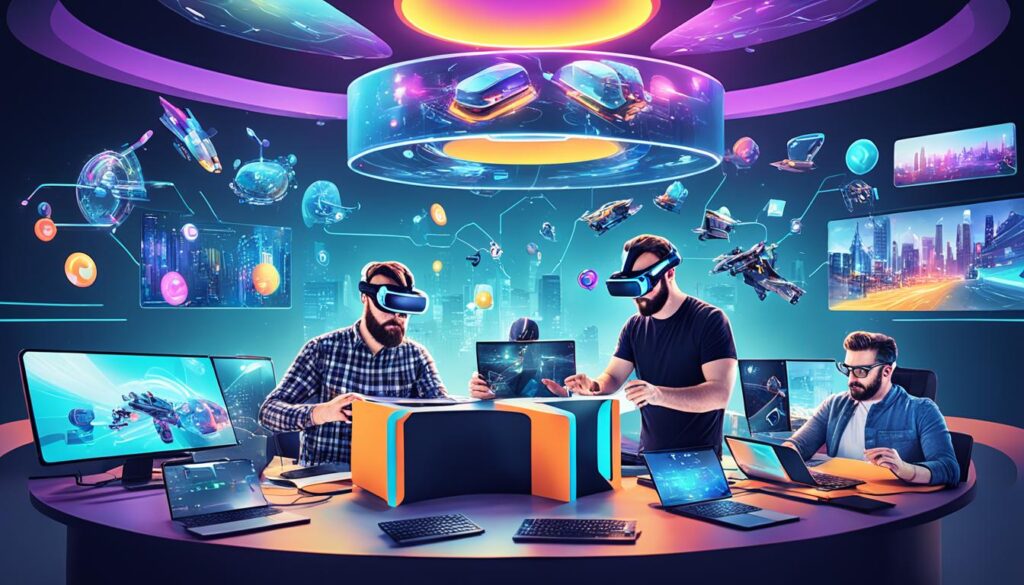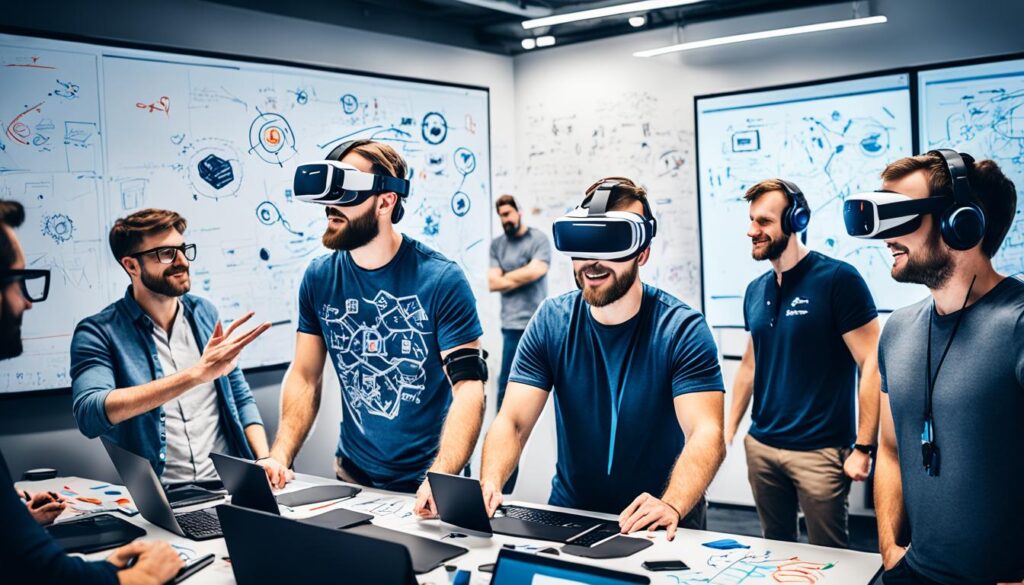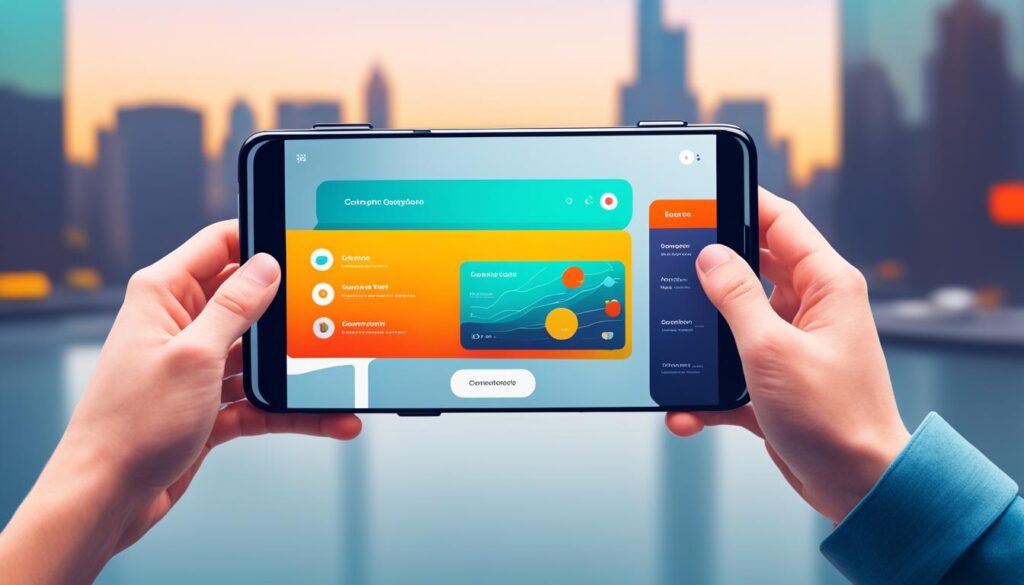The digital world is changing fast, with Augmented Reality (AR) and Virtual Reality (VR) becoming more common. These technologies let businesses and developers make experiences that grab users in a new way. They’re used in gaming, entertainment, e-commerce, and education, among others.
This guide will cover the basics of making AR and VR apps. We’ll look at what makes these technologies different and why people want more immersive experiences. We’ll also talk about the key tools and software you need for success. By the end, you’ll know how to make AR and VR apps that really stand out.
Table of Contents
Key Takeaways
- Understand the fundamental differences between Augmented Reality (AR) and Virtual Reality (VR) technologies.
- Recognize the growing demand for immersive experiences across diverse industries.
- Explore the essential tools and software required for successful AR and VR app development.
- Learn about the principles of user experience (UX) design for creating intuitive and engaging interfaces.
- Discover strategies for integrating sensors and input devices to enhance the user experience.
Introduction to AR and VR App Development
Technology is changing fast, and augmented reality (AR) and virtual reality (VR) are leading the way. These technologies are changing how we use digital content. They promise to revolutionize many areas like gaming, shopping, learning, and healthcare.
Understanding the Difference Between AR and VR
AR and VR are both part of extended reality (XR). AR adds digital info to the real world, making it more interactive. VR takes you into a world made by a computer, fully immersing you in it.
Growing Demand for Immersive Experiences
More people want immersive technology trends because they see how AR and VR can make things better. In many fields, the XR app development landscape is changing fast. New apps are showing how AR vs VR differences can change how we do things, learn, and have fun.
The need for immersive experiences is growing, offering big chances for AR and VR app makers. By understanding these technologies and the latest immersive technology trends, developers can make apps that grab users’ attention like never before.
“The future of computing is immersive, and AR and VR will play a crucial role in shaping that future.”
Choosing the Right Development Platform
Choosing the right platform for AR and VR apps is crucial for success. The market has many AR/VR development platforms, each with special features. Knowing what to look for helps pick the best one for your needs.
Look at how well the platform supports cross-platform app creation. Unity and Unreal Engine let developers make apps for many devices, including AR and VR. This is key for reaching more people and making your app more popular.
Think about the platform selection criteria too. Consider the devices you want to use, the tech you need, your team’s skills, and your budget. Some platforms work better for certain devices or projects, so match your choice with your goals and limits.
| Development Platform | Supported Platforms | Key Features |
|---|---|---|
| ARKit (Apple) | iOS devices | Advanced AR capabilities, tight integration with Apple devices |
| ARCore (Google) | Android devices | Robust AR features, broad Android device compatibility |
| Unity | iOS, Android, PC, Console, VR | Powerful game engine, extensive plugin ecosystem, cross-platform support |
| Unreal Engine | iOS, Android, PC, Console, VR | Advanced graphics rendering, comprehensive tool set, cross-platform development |
By looking at the AR/VR platforms and matching them with your project, you can make a successful app. The right platform helps create immersive AR and VR experiences.
Essential Tools and Software for AR/VR Development
Creating immersive AR and VR apps needs special tools and software. These include game engines and 3D modeling suites. They help creators make experiences that take users into new digital worlds.
Game Engines and Development Frameworks
Powerful game engines like Unity and Unreal Engine are key for AR or VR projects. They offer many features for making AR/VR apps. Developers can easily add 3D models, interactive parts, and advanced graphics.
Using these engines, creators can turn their ideas into amazing apps. They work efficiently and flexibly.
3D Modeling and Animation Software
Creating the virtual worlds and objects for AR and VR is vital. Tools like Blender and Maya let designers make detailed, realistic models and animations. These tools help developers control every visual detail, making the experience immersive and engaging.
“Leveraging the right tools and software is essential for unlocking the full potential of AR and VR technologies. Game engines and 3D modeling suites provide the foundation for building truly immersive digital experiences.”
Developing Augmented Reality (AR) and Virtual Reality (VR) Apps
Making AR and VR apps is a detailed process that needs careful planning and execution. The AR app development process and VR app development lifecycle have many stages. Each stage has its own challenges and things to think about.
At the heart of making immersive apps is knowing who will use them, what problems they face, and what they want. This knowledge helps in planning the app’s features, how it looks, and how users will feel when using it.
When developing, you use advanced tech like 3D modeling and real-time rendering. It’s important to make sure the app works well, runs smoothly, and works with the right hardware and software.
| Key Stages in AR/VR App Development | Unique Considerations |
|---|---|
|
|
Creating successful AR apps and VR apps means understanding the special things to think about with these technologies. By tackling the challenges of development, developers can make apps that are engaging and fun for users.
Designing Intuitive User Interfaces
The need for easy-to-use AR/VR experiences is growing fast. AR/VR experiences need to be simple and clear to keep users interested. Good UX design for immersive apps makes experiences fun and memorable.
Principles of User Experience (UX) Design
Key principles guide the creation of easy-to-use AR/VR UI design. These include:
- Spatial Awareness: Helping users know where they are and how to move around.
- Ergonomics: Making interactions comfortable and easy to avoid user fatigue.
- Intuitive Interactions: Using gestures and controls that feel natural.
By using these principles, developers can make AR and VR apps that are engaging and fun. This leads to more people using these apps.
“The true magic of XR lies in its ability to immerse users in entirely new worlds. Designing interfaces that enhance this sense of presence is crucial for the continued growth and success of the industry.”
The AR and VR world is always changing. We need new and user-focused designs. By understanding UX design for immersive apps, developers can make experiences that amaze and please users.
Integrating Sensors and Input Devices
The success of AR/VR app development depends on combining sensors and input devices well. These technologies make immersive experiences possible. They let users interact naturally in augmented and virtual reality.
AR/VR sensor integration is key, especially with motion trackers. These sensors track the user’s body movements. This lets them control actions with head, hand, and eye gestures. It makes interactions feel real and smooth.
But it’s not just about motion tracking. Hardware-software integration for XR also means using depth sensors and eye-tracking systems. These tools help with 3D spatial awareness, recognizing objects, and interacting with your gaze. They make AR and VR more immersive and interactive.
“The key to unlocking the true potential of AR and VR lies in the seamless integration of cutting-edge sensors and input devices.”
Developers must balance hardware and software in AR/VR systems. This ensures the experiences are intuitive, responsive, and engaging. A well-rounded approach to AR/VR sensor integration and immersive input methods is crucial. It helps these technologies become more popular and successful.
| Sensor Technology | Key Capabilities | Applications |
|---|---|---|
| Motion Trackers | Precise tracking of head, hand, and eye movements | Gaming, training simulations, virtual collaboration |
| Depth Sensors | Accurate 3D spatial awareness, object recognition | Augmented reality, virtual interior design, gaming |
| Eye Tracking | Gaze-based interactions, attention monitoring | User experience optimization, market research, gaming |
Creating Immersive and Engaging Experiences
In the world of Augmented Reality (AR) and Virtual Reality (VR), making experiences immersive and engaging is key. This section looks at how to use virtual environments and gamification to make the user experience better.
Leveraging Virtual Environments
Creating virtual environments is vital for immersive content. Designers must carefully design worlds that feel real, interactive, and present. By doing this, they can take users to exciting digital places, making them feel fully immersed and engaged.
Incorporating Gamification Elements
Gamification is a strong tool in XR apps, making users more engaged and likely to stay. By adding interactive games, challenges, and rewards, developers can use our natural desire for success and competition. This makes boring tasks fun, pushing users to dive deeper into the virtual world.
Using immersive content creation, designing virtual worlds, and gamification can take AR and VR apps to the next level. It makes them more captivating and keeps users coming back for more.
| Strategies for Immersive Experiences | Key Benefits |
|---|---|
| Virtual Environment Design | Increased sense of presence and engagement |
| Gamification Elements | Enhanced user motivation and retention |
| Blending Realism and Interactivity | Seamless integration of digital and physical worlds |
Testing and Optimization Strategies
Creating immersive AR and VR apps needs careful testing and optimization. This ensures the best experience for users. From performance optimization to thorough user testing for immersive apps, each step is key to improving these advanced technologies.
AR/VR app development faces a big challenge: keeping the performance smooth. AR/VR app testing is crucial for finding and fixing issues like slow frame rates and rendering problems. Through detailed testing, developers can make the app run better, keeping the user fully engaged.
User testing is also vital for AR/VR apps. It helps developers make the app’s user interface and user experience better. By getting feedback from many users, developers can make sure the app is easy to use and moves smoothly between the real and virtual worlds. This ongoing testing and improvement is key to making apps that truly capture users’ attention.
| Testing Strategies | Optimization Techniques |
|---|---|
|
|
By using a detailed approach to testing and optimizing, developers can make AR/VR apps that really grab users. This careful process makes sure the apps work well and are easy to use. It sets the stage for success in the fast-changing world of immersive tech.
Monetization Models for AR/VR Apps
As more people want immersive experiences, app makers are looking at different ways to make money. They’re finding in-app purchases and subscription-based pricing work well. These methods help make sure AR/VR apps can keep going.
In-App Purchases for XR
In-app purchases are now common in AR and VR apps. They let users buy extra content, features, or virtual items. This is especially true for games and fun apps, where people are often happy to pay for more.
Developers can make more money by offering smart in-app purchase options. This way, they don’t ruin the main experience for users.
Subscription Models for Immersive Apps
Subscription models are becoming popular too. They give developers a steady income by charging users over time. This is good for apps that keep giving value, like educational tools or big content libraries.
Creating a great subscription experience is key. Developers should mix free and premium features to keep users interested.
Choosing how to make money from AR/VR apps depends on the app’s goals and who uses it. Developers should look at the good and bad of each method. This helps them pick the best way to make money from their apps.
“The key to successful AR/VR app monetization is to strike the right balance between providing value to users and generating revenue for the business.”
Emerging Trends and Future of AR/VR
The AR/VR industry is moving fast with new trends that will change immersive technology. Experts see big things coming as more people want XR experiences.
AI and machine learning are becoming key in AR and VR. They make virtual worlds smarter and more interactive. Users can now interact with digital stuff in a more natural way.
5G technology is also playing a big role. It will make AR and VR smoother by speeding up data and cutting down on delays. This will help these technologies fit into more areas, like gaming, shopping, and learning.
AR and VR are coming together, creating new kinds of experiences. This mix will lead to more flexible and useful immersive solutions.
Experts say we’ll see more affordable and lightweight AR/VR hardware soon. This will make these technologies available to more people. Also, better haptic technology and eye-tracking will make virtual experiences feel more real.
The future looks bright for AR/VR. They will blend into our lives more, changing how we work, learn, and have fun.
“The future of AR and VR is not just about the technologies themselves, but how they can be leveraged to create truly transformative experiences that enhance our lives in meaningful ways.”
Embracing the Potential of Immersive Technology
As immersive technology grows, it’s important for businesses and people to keep up. Knowing the new trends and adapting will help them use the big chances this industry offers.
Overcoming Challenges in AR/VR Development
Creating augmented reality (AR) and virtual reality (VR) apps has its challenges. Two big ones are making them run smoothly and dealing with hardware limits.
Performance Optimization for XR
AR/VR apps need to be smooth and quick for a great experience. Developers work hard to make sure they run well. They use techniques like:
- Leveraging mobile-friendly graphics rendering engines
- Implementing efficient resource management strategies
- Optimizing asset loading and caching
- Utilizing multi-threading and asynchronous processing
This helps make AR/VR experiences that grab users and don’t let them down.
Hardware Constraints in Immersive Apps
AR/VR devices have their own limits that developers must think about. Things like not enough power, limited memory, and battery life can make making apps tough. To beat these issues, developers can:
- Develop for the device’s abilities
- Optimize asset size and complexity
- Implement power-saving techniques
- Explore new ways to combine hardware and software
By tackling these AR/VR development challenges, developers can make apps that work great, are easy to use, and don’t get held back by hardware constraints in immersive apps.
Case Studies and Success Stories
In the world of augmented reality (AR) and virtual reality (VR) app development, success stories are key. They show the huge potential of these immersive technologies. Let’s look at some AR/VR app case studies that have made a big impact.
The IKEA Place app is a great example. It lets customers see IKEA furniture in their homes before buying it. This successful immersive app has changed how people shop for furniture. It helps customers see how products will look and fit in their spaces.
This app uses AR technology to make shopping easier. It has led to happier customers and more sales for IKEA.
Another great example is the Surgical Theater platform. It gives surgeons 3D views of patients’ bodies from CT and MRI scans. This VR tool helps surgeons plan and practice surgeries. It makes surgeries safer and improves patient care.
“Immersive technologies like AR and VR have the potential to revolutionize how we interact with the digital world, and these case studies are just the tip of the iceberg.”
These examples show how AR/VR app case studies are full of new solutions. They’re changing many industries. By looking at these successful immersive app examples, developers and businesses can learn a lot. This can lead to more exciting advancements in the future.
Best Practices for AR/VR App Development
Creating great AR and VR apps needs a deep understanding of design, tech, and business aspects. Here are some top tips for your AR/VR app development:
- Prioritize User Experience (UX) Design: Make sure your app is easy to use and takes full advantage of AR and VR. Use natural ways to interact, clear signs, and keep it simple.
- Leverage Immersive Environments: Use virtual worlds to take users on a journey. Add fun elements and stories to make the experience unforgettable.
- Optimize for Performance: Make sure your app works well by optimizing for hardware limits, reducing delays, and choosing performance over looks when needed.
- Embrace Iterative Development: Work in an agile way, testing and improving your app with user feedback. Keep updating the design, features, and tech to make it better.
- Explore Monetization Strategies: Try different ways to make money, like in-app buys, subscriptions, and ads, to make your AR/VR app successful.
By using these tips, you can make your AR/VR app development better and more successful. This will give your users immersive experiences they’ll love.
| Best Practices | Key Considerations |
|---|---|
| Prioritize User Experience (UX) Design | Intuitive interfaces, natural interactions, clear visual cues, minimized cognitive load |
| Leverage Immersive Environments | Engaging virtual environments, gamification elements, storytelling techniques |
| Optimize for Performance | Hardware limitations, latency reduction, balancing visual fidelity and performance |
| Embrace Iterative Development | Agile approach, continuous testing and refinement based on user feedback |
| Explore Monetization Strategies | In-app purchases, subscriptions, advertising models |
By following these best practices, you can make your AR/VR app development better and more successful. This will give your users immersive experiences they’ll love.
“The secret to creating successful AR and VR apps is finding the perfect balance between technological innovation and user-centric design.”
Conclusion
AR and VR app development is growing fast and full of new chances for making unique and fun experiences. We’ve looked at the main parts of making AR/VR apps. This includes knowing the differences between them, picking the right tools, and using important software.
As more people want immersive experiences, making apps easy to use is key. It’s also important to use sensors, create engaging virtual worlds, and know how to make games. Plus, apps need to work well and use technology wisely.
This article gives a full guide for those in the field of AR/VR app making. It helps developers, designers, and businesses use these new technologies well. By keeping up with trends and solving challenges, companies can lead in the immersive tech world. They can make experiences that really grab and keep the audience’s attention.













